
Enrique Quirós Quirós has faith in Saint Charalambos, patron saint of Bagaces, that he will one day receive a new kidney. He rocks his body from one side of the bed to the other. On the lower left side of his abdomen, a tube sticks out, dripping a yellowish liquid. “If it were yellower, that means there is peritonitis and I’d have to run out of here.”
He talks about his own urine with familiarity, like a mechanic that explains what oil should look like when it comes out of a motor. Clear, clear.
What Enrique dispels from his body isn’t technically urine, but serum that, six hours ago, made his abdomen inflate like a balloon, and that now drains out of his body into a plastic bag.
“As long as the kidneys aren’t working, food and water are a poison that spins around inside.”
This waste is what no longer filters through any of the three kidneys he has in his body (two of his own and one that his sister donated).
Not only patients suffer from the disease, but also their families
All three have been damaged by the chronic kidney disease that he suffers from.
Saying that they were damaged by CKD sounds sterile, scientific, and almost innocent. In reality, they were damaged by poverty, abandonment, endless days under the relentless Guanacaste sun, a lack of hydration and ignorance. And, of course, finally CKD, the same silent plague that buried 1,744 Guanacastecans between 1990 and 2013.
The greatest fear, among many for this 45-year-old Bagaces native, is that a bacteria enters his body and fills him with pus. “That’s how my brother-in-law died. Edwin Torres was his name.”
If his peritoneum gets infected, which is a small membrane that covers the organs inside the abdominal cavity, he gets peritonitis and the doctors prohibit him from treating himself at home. He would be enslaved once again in the Liberia hospital.
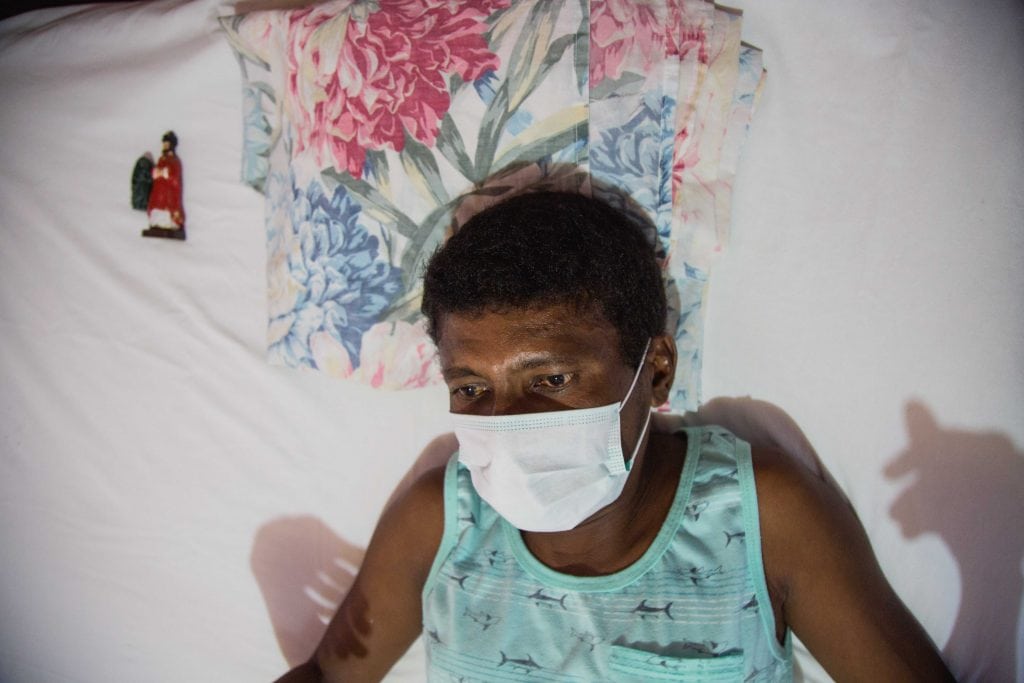
Enrique Quirós Quirós is a CKD patient who lost his three kidneys because of the disease. Photo by César Arroyo.
The doctors say that, in the hospital, patients are exposed to deadly bacteria. That’s why they ask them to do home treatment in a safe room if they are able. It’s impeccable and unpolluted. Inviting us in to see his safe room seems to give him a tremendous sense of pride.
“I put in a ceiling and a sink and here a fan,” he says in a voice that seems to be accustomed to sacrifices.
The heat melts us. It’s been raining everywhere except here. “Barely a drop.”
The rest of the house, where he lives with his mother and niece, has a tin roof. They don’t have enough money for anything more with their pensions of ¢130,000 per month ($200 in the most expensive country in Central America).
It’s the same thing four times a day. Wash his hands for five minutes, lay in bed, move from one side to another in order to “empty myself well, until my testicles hurt.” Weigh his “urine” and write it down in a chart. Inflate himself again and wait until it’s 10am, 4pm, 10pm again and remember, at least once in awhile, that without this procedure his illness would kill him in a matter of days.
It would kill him like it killed his father, Bernardo Quirós Ordóñez, 10 years ago, or his brother-in-law Luis Segundo Umaña 12 years ago. Or his other brother-in-law Secundino Umaña four years ago, as the poorest farmers in Cañas and Bagaces die: under the sun with destroyed kidneys.
In Costa Rica, there are 280 people waiting for a kidney from a cadaver and Guanacaste is one of the provinces that has the fewest number of people registered as donors.
***
There is no ailment in Costa Rica that has mortality rates that are growing more than Chronic Kidney Disease (CKD).
Not even cancer. “On the rise, we could say cancer, but it doesn’t stand out as much or is as significant as chronic kidney disease,” says doctor Daniel Salas, director of health ministry’s department of health security.
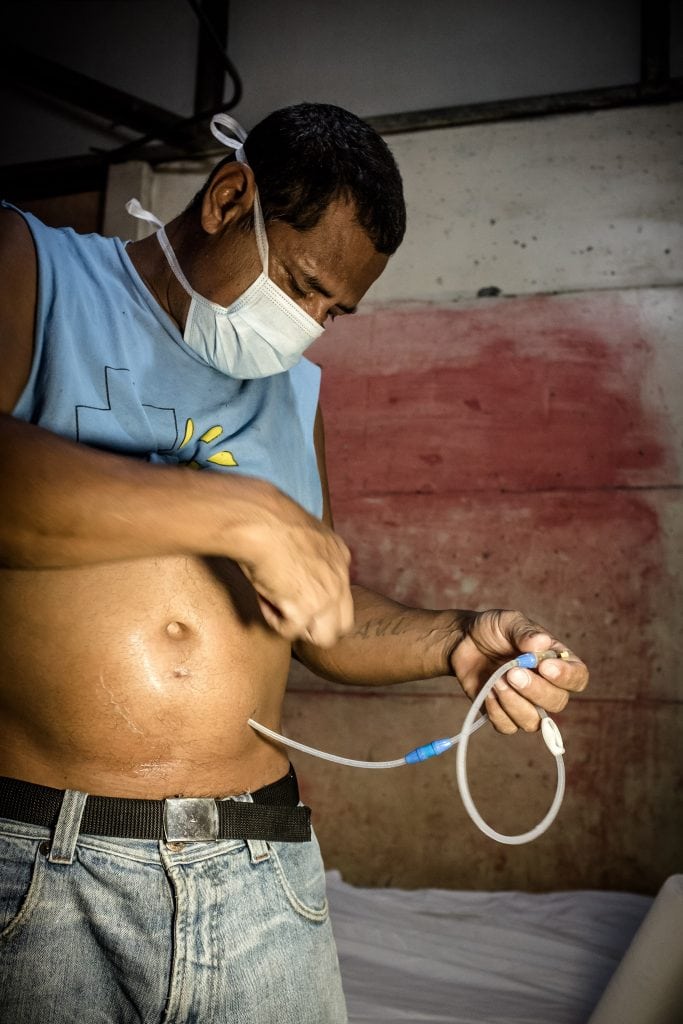
David Villalobos López es Nicaraguan, like many other people who work in cane plantations. He has to receive dialysis four times a day. Photo by Miriet Ábrego.
In Guanacaste alone, CKD has killed 1,744 people in two decades and the number is rising. The province with the smallest population in the country accounts for 26 percent of hospitalizations for this illness.
Scientists refer to it as an epidemic, but the Costa Rican health system downplays it. They don’t recognize it as an “epidemic” in any official document and there aren’t even any concrete statistics on how many people get CKD each year (while they do have numbers for dengue and zika, for example).
“It wasn’t mandatory to notify about this illness until 2017,” Salas explains. There are only hospitalization data, which are “clearly insufficient,” he quickly adds.
Even more hidden among the Costa Rican statistics are the victims whose CKD is, as scientists would say, due to “non-traditional” causes, meaning that it’s not triggered by hypertension or diabetes, but a mysterious cause that scientists have practically discovered: work. Brutal work under the sun in the sugar fields.
***
Nine years ago, researcher Jennifer Crowe arrived in Guanacaste with the National University’s Health, Labor and Environment department and stayed in the sugar fields to interview the men who cut and processed cane for a Guanacaste sugar mill.
“There was suspicion of a rare kidney disease going on there, something that still didn’t have a name and without an understanding of its dimensions,” said the United States citizen in a thick accent, but in Spanish filled with meaning.
The cane cutters spoke about the heat, the long days and a lack of water. She noted that across the globe, scientists were speaking more and more about how infrequently public policy included the most vulnerable workers – like Enrique, his dead father and his dead brothers-in-law – in their plans for climate adaptation. Jennifer wanted to understand.
For the next few years, she and several dozen researchers from around the world studied the phenomenon in Costa Rica’s northern Pacific region, El Salvador and Nicaragua. The epidemic also reaches Guatemala and Mexico and they called it the Mesoamerican nephropathy.
They researched everything they could, from agrochemicals and toxic metals to painkillers, exhausting work days, the heat and the sugarcane.
In 2015, Jennifer Crowe and 78 colleagues reached a consensus. Chronic kidney disease due to non-traditional causes has at least one risk factor: the physical effort farm workers make when they do hard jobs like cutting cane under the sun, an activity in which the illness multiplies.
Or, in her own words as published in the summary of the scientific research: “Growing evidence exists about the causal role that exhausting work, heat and lack of hydration have as risk factors for Mesoamerican nephropathy.”
It was the second time they got together to talk and it came with controversy because of the business owners who financed their study, some of whom are involved in the sugar business, and because of the political weight of concluding that farm workers in Central America’s Pacific region were working to die, not live.
The same year, the Government of Costa Rica signed a decree that required agriculture companies to give rest and hydration to workers. The document recognizes that the heat is a danger, but it doesn’t mention workers who aren’t formal company employees nor those who do contract work per planted acre, like Enrique and a large part of his family.
“They are important advances. The country has been a pioneer,” says Jennifer Crowe. But the state of Costa Rica still doesn’t recognize that the chronic kidney problems that Guanacaste farmers face is a labor risk.
This is partly because there is no conclusive clinical study that shows a direct, unequivocal link between the illness and the job, explains the director of health security Daniel Salas.
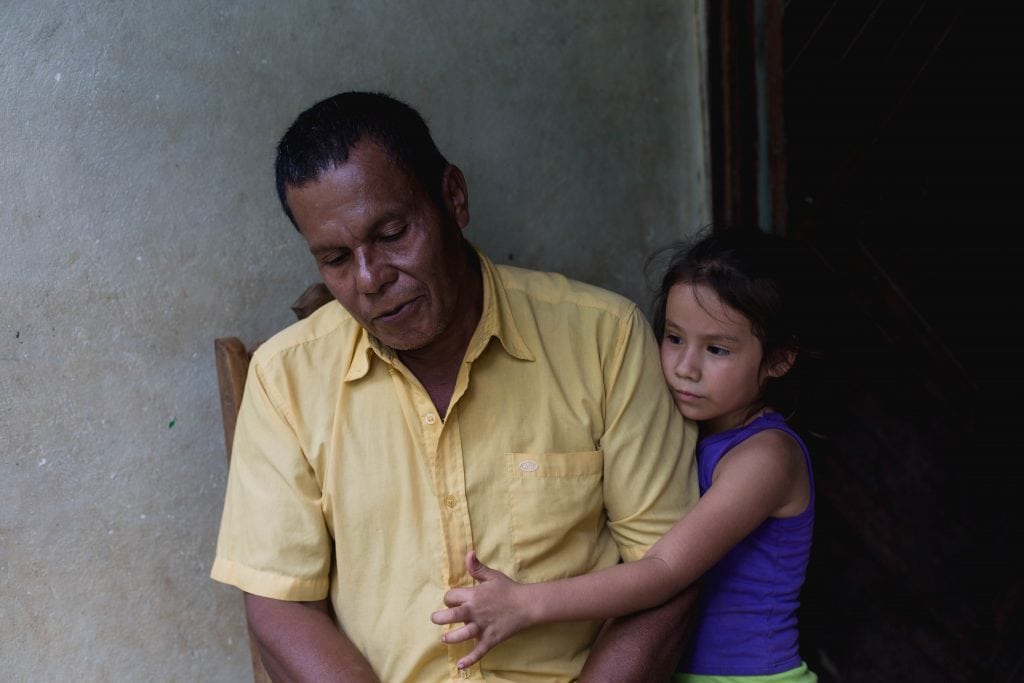
Dimas López Carrillo lives in Aguacaliente de Bagaces. He fed his family, but now he can’t work so he can’t maintain his children. Photo by César Arroyo.
That’s why the National Insurance Institute (INS), the state entity where companies insure their workers for job-related risks, doesn’t compensate farmers that suffer from CKD. Then the responsibility falls on the Costa Rican Social Security Institute, which spends around $25 million per year on kidney dialysis and another $5.5 million on peritoneal dialysis.
Meanwhile, the government is going through its usual steps. The health ministry says that the social security institute needs to know how much Costa Rica spends on preventing the disease, and the social security institute says it’s the other way around. The labor ministry doesn’t answer emails. Perhaps what’s happening is what doctor Salas describes.
“We are working a lot, evaluating each part’s responsibility, what is the INS’s responsibility, what is the responsibility of social security…”
As more studies are needed, the researchers haven’t ruled out that the illness has a genetic component. But they have linked the illness to the consumption of some anti-inflammatory drugs and contact with agrochemicals.
All these official remarks and theories sound very scientific and verifiable, but worlds away from the lived experience of a man like Israel Lazo, who works as a farmhand with a wife, three children and a daily habit of pills to battle his CKD. One day Israel will need to perform dialysis every six hours like Enrique; the farmer has resigned himself to the fact his life will change. “Only God knows,” Israel says.
***
Pedro Alvarado Quirós, Enrique’s uncle, wants it to rain. Under a dense almond tree with his shirt rolled up around his waist, he slaps his leg and leaves the mosquito blood there as he complains about the corn that he planted. “It doesn’t grow,” he tells me.
Here in Aguacaliente de Bagaces, a very small town located 11 kilometers (6.8 miles) from the center of the canton, almost everyone is family. Almost everyone works or used to work in sugarcane or rice fields because there isn’t much else. Almost everyone has one kidney fewer than they should, or three damaged ones, or two in process. Almost no one is above the poverty line.
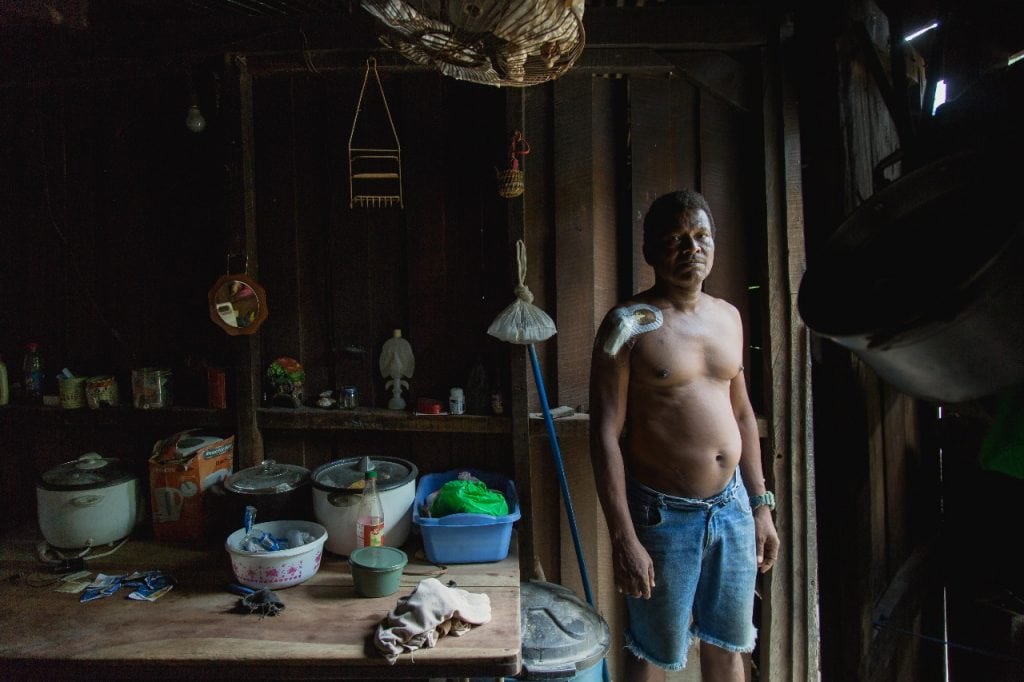
Pedro Alvarado Quirós has to go to Hospital Mexico three times a week to change all his blood with a machine. Photo by César Arroyo.
Neither is Pedro. “The catheter got infected twice and I went for dialysis.” Pedro travels three times per week to the Mexico hospital in San Jose so that they can change all his blood with a machine. It takes all day. He can’t work. Doctors and fatigue don’t let him work anyway.
“That’s where I spend my time. I’m fine as long as I’m seated and resting. I don’t feel anything. But I used to like to roam and cut plants,” he says. He talks about his work as though he would have enjoyed it. He lives on ¢130,000 ($200) per month from his state pension. “I fought for seven years for them to give it to me and I spend almost all of it on food when I go to San Jose, because I have to buy lunch. The breakfast is included.”
What the scientists haven’t studied are the links between the ill patients and poverty, a lethal combination. “[In science] you have to be very objective,” says Jennifer Crowe. “So we forget about [people’s stories], which is the most important.”
During the seven years that Pedro fought for his pension, he was under treatment. When we met him a year-and-a-half ago he was waiting for a kidney. His sister Mireye donated one for him, but “it didn’t stick” and he lost it. In reality, they both lost it. Or everyone. A single kidney transplant costs the state $30,000 (about 16 million colons). Now, once again, the waiting list of people hoping for a kidney has grown. As of this June, there were 280 people on it across the country.
Most of us could give away one of our kidneys if we died in an accident, “but the organ donor culture isn’t big in this country,” says Hugo Delgado, head of the Nicoya dialysis unit. In fact, Guanacaste is the province with the fewest number of people in the social security institute’s electronic donation system.
Kidney dialysis is only done in hospitals in the central valley where there are specialists in nephrology. In Liberia, there aren’t any.
Many of Pedro’s neighbors still don’t need dialysis, but they will need it someday. With this illness, the handwriting is on the wall. Pills, unlike hope, don’t last forever. They also don’t heal. The illness is never reversed, it only advances. First pills, then peritoneal dialysis, then kidney dialysis. And, maybe one day, a new kidney. CKD is slow-moving, but it advances, like time under this almond tree.
***
On the pink walls of Enrique Quiros’s home hang two portraits of the dead. “He was my husband. He died because he didn’t want to have dialysis,” says Juana Quirós with her eyes chiseled, skin like polished copper and eternal dimples.
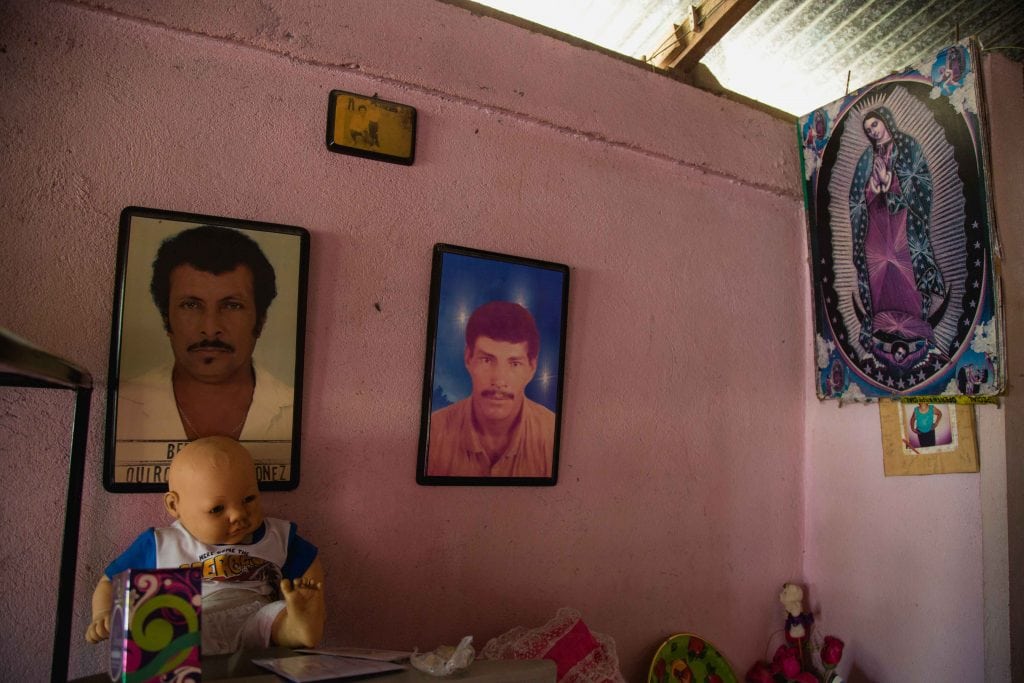
All that’s left of Bernardo Quirós and Luis Segundo, mortal victims of CKD, are these pictures on the wall of Juana Quirós’s, Bernardo’s widow and Luis’s mother-in-law. Photo by César Arroyo.
“We never knew what happened to him. They say it’s the water [before it was believed the water contained arsenic]. They told me it was because he had high blood pressure,” says Enrique Quirós, Juana’s son, when asked about what the doctors told him. Like him, many in Aguacaliente de Bagaces don’t know or don’t bother to ask. “We focus on solving the problem,” they say.
On the bed with the white sheet lays an image of the Virgin of Los Angeles and another one of the Saint Charalambos. “He once cured an entire town of a plague that was killing its people,” Enrique says without realizing it. Outside, a downpour falls for the first time in weeks.




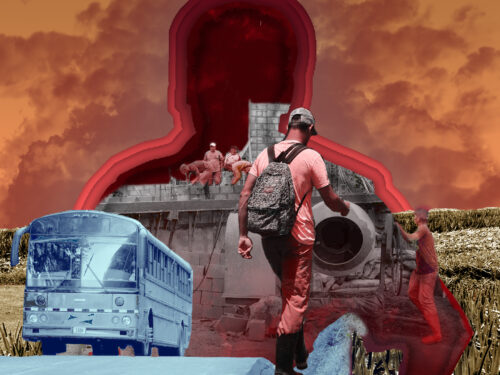

Comments